Thoroughly analyzing AP Inter 2nd Year Botany Model Papers Set 1 helps students identify their strengths and weaknesses.
AP Inter 2nd Year Botany Model Paper Set 1 with Solutions
Time: 3 Hours
Maximum Marks: 60
Section A
10 × 2 = 20 Marks
Answer all the questions
Question 1.
Define water potential. What is the value of water potential of pure water?
Answer:
‘Water potential is defined as the chemical potential of water and a measure of energy for reaction or movement. The value of water potential of pure water is zero.
Question 2.
Which of the PGRs is called stress hormone and why?
Answer:
ABC (Abscisic acid) is called stress hormone. ABA stimulates the closure of stomata in the epidermis and increases the tolerance of plants to various kinds of stresses.
Question 3.
What are pleomorphic Bacteria? Give an example.
Answer:
Some bacteria change their shape depending upon the type of environment and nutrients available are called pleomorphic bacteria.
Ex: Acetobacter.
Question 4.
Explain the terms phenotype and Genotype.
Answer:
The physical or external appearance of a character is called phenotype. The genetic makeup of an individual is called a Genotype.
![]()
Question 5.
What is the function of DNA polymerise?
Answer:
DNA polymerise is a highly efficient enzyme which catalyse polymerisation of a large number of nucleotides in a short time.
Question 6.
Name any three viruses which have RNA as the Genetic Material.
Answer:
Tobacco mosaic virus, QB bacteriophage, HIV
Question 7.
Expand GMO. How is it different from a hybrid?
Answer:
GMO stands for Genetically Modified Organisms. It is an organism that contains one or a few genes from another species. Whereas Hybrid is an organism resulting from a cross between two different genera, species or varieties.
Question 8.
Give any two reasons why the patent on Basmati should not have gone to American company.
Answer:
New variety of Basmati had actually been derived from Indian farmer vanities. Indian Basmati was crossed with semi-dwarf varieties and claimed as an invention or a novelty.
Question 9.
What is meant by hidden hunger?
Answer:
It is a chronic lack of vitamins and minerals that often has no visible warning signs. It leads to mental impairment, poor health and productivity or even death.
Question 10.
Give any two mIcrobes that are useful in biotechnology.
Answer:
Eschericia coli, agrobacterium tumifasciens.
Section B
6 x 4 = 24 Marks
Question 11.
Transpiration is a necessary evil’. Explain.
Answer:
Transpiration has both beneficial and harmful effects. They are:
Beneficial effect:
- It help in passive absorption of water.
- It also helps in passive absorption of mineral salts by mass flow mechanism.
- It is the main force for ascent of sap.
- It regulates the temperature of plant body and provides cooling effect.
Harmful effect:
- Excessive transpiration makes the cells flaccid which records growth.
- Excessive transpiration leads to closure of stomata thus obstructing gaseous exchange. Hence transpiration is considered to be a necessary evil.
![]()
Question 12.
Explain the steps involved in the formation of root nodules.
Answer:
- Roots of legumes release sugars, Amino acids which attached
- Rhizobium. They get attached to epidermal and root hair cells of the nos.
- The root hair curl and the bacteria invade the root hair
- An infection thread produced carrying the bacteria into cortex of the root
- Bacteria initiate nodule formation in the cortex of the root. Then the bacteria released from the thread into the cortical cells of the host and stimulate the host cells to divide.
- Thus leads to the differentiation of specialized nitrogen-fixing cells.
- The nodule thus formed establishes a direct vascular connection with the host for exchange of nutrients.
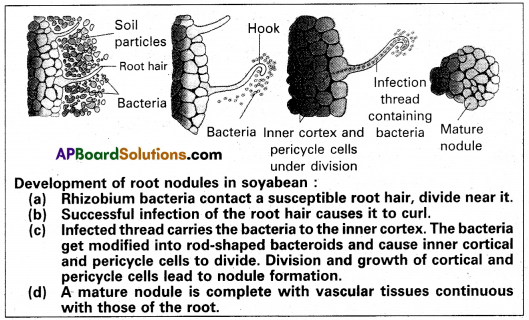
Question 13.
With the help of a diagram, explain briefly the process of cyclic photophosphorylation.
Answer:
The process through which ATP is synthesized by cells is called phosphorylation. It occurs in the presence of light so called photo phosphorylation. It is of 2 types.
a) Cyclic
b) Non-cyclic.
Cyclic photophosphorylation: The cyclic movement of electrons from PSI to same reaction center through electron carriers is called cyclic photophosphorylation. In this only PS I is involved. During the flow of electrons, phosphorylation occurs in the stroma lamellae which lacks PS II and NADP reductase enzyme. The excited electrons do not pass on to NADP+ but as cycled back to the PS I through electron carriers. It occurs when only light of wavelength is beyond 680 nm i.e., 700 nm. The cyclic flow hence, results only in the synthesis of ATP but not NADPH + H+. In green plants, cyclic photophosphorylation is an additional source of ATP required for chloroplast Activities.

Question 14.
Write short notes on seed dormancy.
Answer:
The inability of seed to germinate or grow is called dormancy It may be due to either external factors or internal factors.
Internal factors:
- Immature embryo: The embryo has not reached morphological maturity to germinate. E.g.: Ranunculus
- Hard seed coat: In fabaceae membranes, seed have hard seed coats which prevent uptakes of oxygen or water. It can be broken by scarification in which the hard seed coat is ruptured or weakened.
- Chemicals: Seeds of some plants (tomatoes) contain chemical compounds which inhibit their germination.
External factors:
- Low temperature treatment: Many seeds (polygonum) with not germinate until they have been exposed to low temperature in moist conditions in the presence of oxygen for weeks to months. The practice of layering the seeds during winter in moist sand and peat is called stratification or prechilling.
- Seeds of many domestic plants may be limited only by lack of moisture or warm temperature.
Question 15.
Explain the structure of TMV.
Answer:
- It is a rod-shaped virus. It is about 300 nm long and 18 or 19 nm in diameter with a molecular weight of 39 X 106 daltons.
- The capsid is made up of 2,130 sub-units called capsomeres.
- Capsomeres are arranged in a helical manner around a central core of 4 nm.
- Each protein sub-unit is made up a single polypeptide chain with 158 Amino acids.
- Single-stranded RNA is present inside the capsid and is spirally coiled.
- RNA of TMV Consists of 6,500 nucleotides.
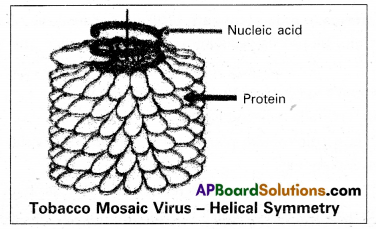
Question 16.
Explain the law of dominance using a Monohybrid cross.
Answer:
Characters are controlled by discrete units called factors. Factors occur in pairs. In a dissimilar pair of factors pertaining to a character, one member of the pair dominates the other. The law of dominance is used to explain the expression of only one of the parental characters in a Monohybrid cross in the F1 generation and the expression of both in F2 generation in the ratio of 3:1.
![]()
Question 17.
Write the important features of Genetic code.
Answer:
- The codon is triplet of 64 codons, 61 codons code for 20 amino acids and 3 codons do not code for any amino acids (stop codons, UAA, UAG, UGA).
- One codon codes for only one amino acid, hence it unambiguous and specific.
- Some amino acids are coded by more than one codon, hence the code is degenerated.
- The codon is read in mRNA in a contiguous fashion. There are no punctuations.
- The code is nearly universal.
For Ex: UUU code for phenylalanine (phe) in bacteria or humans. - AUG code for methionine and also acts as initiator codon.
Question 18.
List out the beneficial aspects of transgenic plants.
Answer:
Plants with desirable character creates through gene transfer methods are called transgenic plants. Beneficial aspects are:
a) Transgenic crop plants are efficient because they have many beneficial traits like virus resistance, insect resistance and herbicide resistance.
- Papaya in resistant to papaya ring root virus.
- Bt. cotton is resistant to insect.
- Transgenic tomato plants are resistant to bacterial pathogen pseudomonas.
- Transgenic potato plant are resistance of fungus Phytophthora.
- Transgenic plants which are suitable for food processing are produced with improved nutritional quality.
E.g.:
- Transgenic tomato ‘flavr savr are bruise resistant i.e., suitable for storage and transport due to delayed ripening and offers longer shelf life.
- Transgenic Golden Rice Taipei is rich in vitamin A and prevents blindness.
c) Transgenic plants are used for hybrid seed production.
E.g.: Male sterile plants of Brassica napus are produced. This will eliminate the problem of manual emasculation and reduce the cost of hybrid production.
d) Transgenic plants have been shown to express the genes of insulin, Interferon, human growth, hormones, Antibiotics, Antibodies etc.
e) Transgenic plants are used as bio-reactors for obtaining commercially useful products specalized medicines and Antibodies on large scale is called molecular farming.
f) Transgenic plants tolerant to Abiotic stresses caused by chemicals, cold. drought, salt, heat, etc.
- Basmati variety of rice was made resistant against biotic and abiotic stresses.
- Round-up-ready soybeans is herbicide tolerant.
Section – C
2 x 8 = 16 Marks
Question 19.
Explain the reactions of Krebs cycle.
Answer:
The acetyl CoA enters into the [mitochondrial matrix] a cyclic pathway tricarboxylic acid cycle, more commonly called Krebs cycle after the scientist Hans Krebs who first elucidated II.
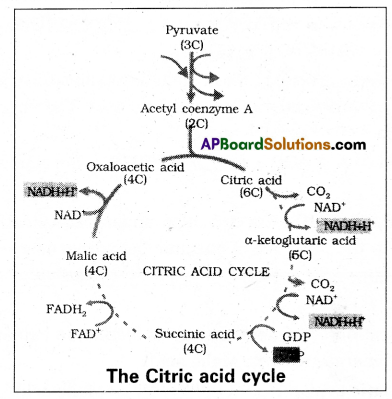
1. Condensation: In this acetyl CoA condenses with oxaloacetic acid and water to yield citric acid in the presence of citrate synthetase and CoA is released.
![]()
2. Dehydration: Citric acid looses water molecules to yield cis aconitic acid in the presence of aconitase.
![]()
3. Hydration: A water molecule is added to cisaconic acid to yield isocitric acid in the presence of a conitase.
![]()
4. Oxidation T: Isocitric acid undergoes oxidation in the presence of dehydrogenase to yield succinic acid.

5. Decarboxylation: Oxalosuccinic acid undergoes decarboxylation in the presence of decarboxylase to form α-keto glutaric acid.
![]()
6. Oxidation II, decarboxylation: α – keto glutaric acid undergoes oxidation and decarboxylation in the presence of dehydrogenase and condenses with co.A to form succinyl co. A.

7. Cleavage: Succinyl Co.A splits into succinic acid and co.A in the presence of thiokinase to form succinic acid. The energy released is utilised to form ATP from ADP and PI.

8. Oxidation – III: Succinic acid undergoes oxidation and forms Fumaric acid in the presence of succinic dehydrogenase.

9. Hydration: A water molecule is alcohol to Fumaric acid in the presence of Fumarase to form Malic acid.
![]()
10. Oxidation IV: Malic acid undergoes oxidation in the presence of malic dehydrogenase to form oxaloacetic acid.

In TCA cycle, for every 2 molecules of Acetyl co.A undergoing oxidation, 2 ATP, 8 NADPH+ H+, 2FADH2 molecules are formed.
Question 20.
Explain briefly the various processes of recombinant DNA technology.
Answer:
The important methods in recombinant DNA technology are performed through genetic engineering.
They are:
- Isolation of a desired gene
- Insertion of isolated gene into a suitable vector
- Introduction of recombinant vector into a host and
- Selection of the transformed host cells.
i) Isolation of a desired gene:
- The desired gene is isolated from the donor cell. Normally bacteria are the source of desired genes.
- The cell walls of bacteria are degraded with the help of enzymes.
- The cell membranes are lysed with the help of detergents.
- By treating the cellular constituents with phenols and suitable nucleases and by subjecting to gradient centrifugation, pure DNA is isolated.
- The purified DNA is cut into a number of fragments by restriction endonucleases.
- The restriction enzymes cleave DNA molecules in two ways.
i) In one way they cut both strands of DNA at exactly opposite points to each other. This results in DNA fragments with blunt ends or flush ends, where two strands end at the same point. Such cutis generally termed as even cut.
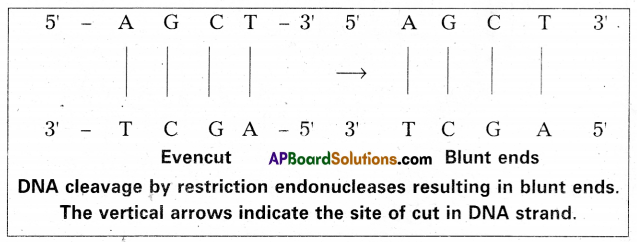
The resultant fragments are separated from each other by gel electrophoresis.
The desired fragments are selected by Southern blotting technique.
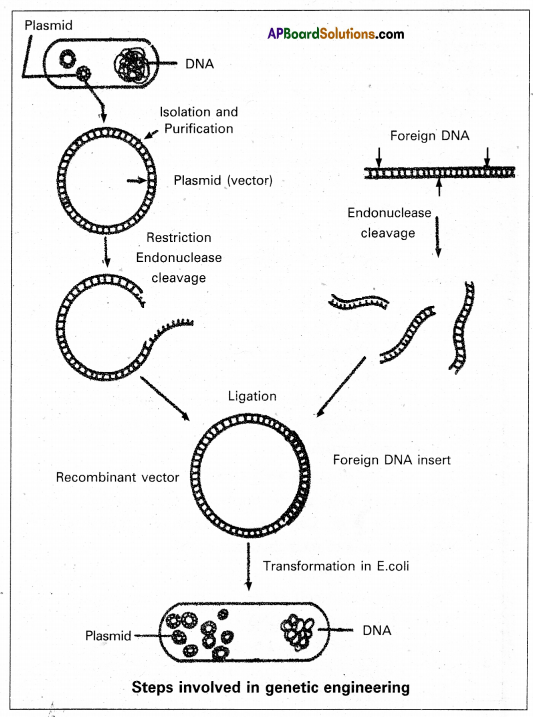
II) Insertion of isolated gene into a suitable vector:
- The selected fragments of DNA are inserted into a suitable vector to produce a large number of copies of genes.
- This is called gene cloning.
- There are two major types of vectors, namely plasmids and bacteriophages.
- Among the two types, plasmids are the ideal cloning vectors.
- To isolate a plasmid. The bacterial cell is treated with EDTA (Ethylene diamine tetra acetic acid) along with lysozyme enzyme to digest the cell wall.
- Then the bacterial cell is subjected to centrifugation in sodium lauryl sulphate to separate the plasmid.
- The plasmid DNA is cut with the help of restriction endonuclease.
- The circular plasmid is converted into a linear molecule having sticky ends.
- The two sticky ends of linear plasmid are joined to the ends of desired gene by DNA ligase.
- The plasmid containing foreign DNA segments is called recombinant DNA (r DNA) or Chimeric DNA.
III) Introduction of recombinant vector into a suitable host:
- The rDNA molecule is introduced into suitable bacterial host cells by transformation.
- The cell containing r DNA is called transformed cell. Bacterial cell walls are not permeable to recombinant vectors,
but keeping in dil. Calcium chloride renders the bacterial cell wall permeable to recombinant vectors. - The rDNA replicates within the host cell.
- The transformed cell grows on the culture medium. Each daughter cell contains r DNA.
IV) Selection of transformed host cells:
1. Selection of transformed cells depends on the nature of gene which is cloned.
2. It can be done in two ways.
They are:
- Without using probes
- By using probes.
Without using probes:
- If the gene is cloned for antibiotic resistance, the cells are first incubated on a medium without antibiotic for one hour, to allow the antibiotic resistance gene to be expressed.
- Then the cells are placed on a medium with an antibiotic for selection of colonies containing rDNA.
- The cells which have expressed the gene will survive and the others die.
b) By using probes: When transformed cells are cultured on the nutrient medium, several cells are produced. To select the cells containing the desired gene colony hybridization method is used. In this gene specific probes are used. A probe is a small fragment of single-stranded RNA or DNA which is tagged with radioactive, molecules. It can search out complimentary DNA sequences from an organism.
![]()
Question 21.
Describe the tissue culture technique and Wh9t are the advantages of tissue culture over conventional methods of plant breeding in crop improvement programmes?
Answer:
Tissue culture Technique:- It involves
a) Preparation of Nutrient medium:- The nutrient medium is a mixture of various essential nutrients, amino acids, vitamins, and carbohydrates. These are mixed in distilled water and P’ is adjusted to 5.6 to 6.0. Growth regulators like auxins, cytokinins are added to the medium. The nutrient medium is poured in glass vessels and closed tightly with cotton plugs before sterilizing them in an autoclave.
b) Sterilisation:- The nutrient medium is rich in nutrients and therefore attracts the growth of microorganisms. The culture medium is autoclaved for 15 mins, at l2L°c or 15 pounds of pressure to make aseptic.
c) Preparation of explant: Any living part of plant can be used as explant. The explants must be cleaned with liquid detergent and in running water and surface sterilised with sodium hypochlorite and rinsed with distilled Water.
d) Inoculation of explants: The transfer of explants onto the sterilized nutrient medium is called inoculation. It is carried out under sterilized conditions.
e) Incubation: The culture vessels with inoculated explants are incubated in a culture room under controlled temperature, optimum light, and humidity. The cultures are incubated for 3-4 weeks, the cells of the explant divide and redivide, producing a mass of tissue called callus. The callus is transferred to another medium containing growth regulators to initiate the formation of roots and leafy shoot (organogenesis). Sometimes embryo-like structures develop directly from the callus which are referred as somatic embryos. These can be encapsulated with sodium alginate to form synthetic or artificial seeds.
f) Acciamatization and transfer to pots: The plants produced through tissue culture are washed gently and are planted in pots kept in glass house for 1-2 weeks. Finally, they are transferred to field.
![]()
Advantages:
- The production of exact copies of plants that produce particularly good flowers, fruits or have other desirable traits.
- To quickly produce mature plants.
- The production of multiples of plants in the absence of seeds or necessary pollinators to produce seeds.
- The regeneration of whole plants from plant cells that have been genetically modified.
- The production of plants from seeds that otherwise have very low chances of germinating and growing i.e., orchids and nepenthes.
- To clean particular plants of viral and other infections and to quickly multiply these plants as cleaned stock for Horticulture and Agriculture.